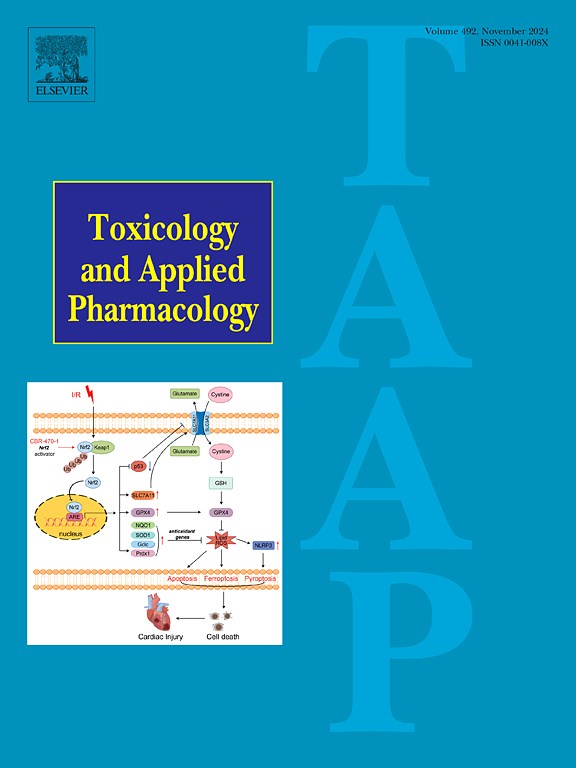Activation of steroid hormone receptors by metabolism-disrupting chemicals
IF 3.3
3区 医学
Q2 PHARMACOLOGY & PHARMACY
引用次数: 0
Abstract
Exposure to metabolism-disrupting chemicals (MDCs), compounds largely belonging to the group of endocrine-disrupting chemicals (EDCs), is associated with metabolic dysfunctions such as dyslipidemia, insulin resistance and hepatic steatosis. Steroid hormone receptors (SHRs) are known targets for MDCs but their regulatory environment in the presence of environmental chemicals remains elusive. Here, we studied the activation and molecular interactions of SHRs exposed to 17 suspected MDCs including pesticides, plasticizers, pharmaceuticals, flame retardants, industrial chemicals and their metabolites by combining in vitro and in silico approaches. We first established and pre-validated reporter gene assays in HepG2 hepatoma cells to assess the activation of estrogen (ER), androgen (AR), glucocorticoid (GR) and progesterone (PR) receptors. Next, using RNA-seq and publicly available protein interaction data, we identified relevant SHR-interacting coregulators expressed in hepatic cells and measured their MDC-dependent interactions with SHRs using the Microarray Assay for Real-time Coregulator-Nuclear receptor Interaction (MARCoNI) technology. Finally, we examined MDC binding to ER and GR using molecular dynamics simulations. These combined approaches lead to identification of MDCs capable of SHR activation at picomolar-to-low micromolar concentrations and paralleled with their ability to induce recruitment of multiple coregulators. MDCs induced distinct SHR-coregulator binding patterns involving multiple coactivators, corepressors and other modulatory proteins. Our results have broadened the test battery to detect MDCs and indicate that the activation of SHRs by MDCs is driven by diverse molecular interactions.
干扰代谢的化学物质激活类固醇激素受体
暴露于干扰新陈代谢的化学品(MDCs)(这些化合物主要属于干扰内分泌的化学品(EDCs))与代谢功能障碍有关,如血脂异常、胰岛素抵抗和肝脏脂肪变性。类固醇激素受体(SHRs)是 MDCs 的已知靶标,但它们在环境化学物质作用下的调控环境仍然难以捉摸。在此,我们结合体外和硅学方法,研究了暴露于 17 种疑似 MDCs(包括杀虫剂、增塑剂、药品、阻燃剂、工业化学品及其代谢物)的 SHRs 的活化和分子相互作用。我们首先在 HepG2 肝瘤细胞中建立并预先验证了报告基因检测方法,以评估雌激素(ER)、雄激素(AR)、糖皮质激素(GR)和孕酮(PR)受体的激活情况。接下来,我们利用 RNA-seq 和公开可用的蛋白质相互作用数据,确定了肝细胞中表达的相关 SHR 相互作用核心调节因子,并利用实时核心调节因子-核受体相互作用微阵列分析(MARCoNI)技术测量了它们与 SHR 的 MDC 依赖性相互作用。最后,我们利用分子动力学模拟研究了 MDC 与 ER 和 GR 的结合。通过这些综合方法,我们鉴定出了能在皮摩尔至低微摩尔浓度下激活 SHR 的 MDCs,同时它们还能诱导多种核心调节因子的招募。MDCs 能诱导不同的 SHR-调控因子结合模式,其中涉及多种辅激活因子、核心加压因子和其他调控蛋白。我们的研究结果拓宽了检测 MDC 的测试范围,并表明 MDC 对 SHR 的激活是由多种分子相互作用驱动的。
本文章由计算机程序翻译,如有差异,请以英文原文为准。
求助全文
约1分钟内获得全文
求助全文
来源期刊
CiteScore
6.80
自引率
2.60%
发文量
309
审稿时长
32 days
期刊介绍:
Toxicology and Applied Pharmacology publishes original scientific research of relevance to animals or humans pertaining to the action of chemicals, drugs, or chemically-defined natural products.
Regular articles address mechanistic approaches to physiological, pharmacologic, biochemical, cellular, or molecular understanding of toxicologic/pathologic lesions and to methods used to describe these responses. Safety Science articles address outstanding state-of-the-art preclinical and human translational characterization of drug and chemical safety employing cutting-edge science. Highly significant Regulatory Safety Science articles will also be considered in this category. Papers concerned with alternatives to the use of experimental animals are encouraged.
Short articles report on high impact studies of broad interest to readers of TAAP that would benefit from rapid publication. These articles should contain no more than a combined total of four figures and tables. Authors should include in their cover letter the justification for consideration of their manuscript as a short article.

 求助内容:
求助内容: 应助结果提醒方式:
应助结果提醒方式:


